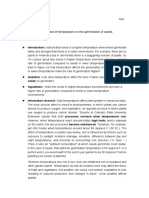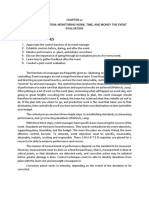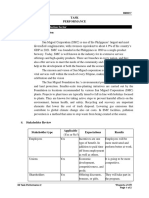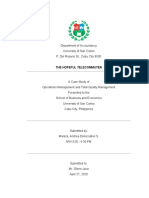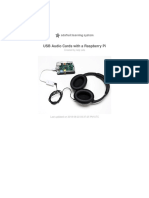Ergonomics Essay
Ergonomics Essay
Uploaded by
Misha JechandCopyright:
Available Formats
Ergonomics Essay
Ergonomics Essay
Uploaded by
Misha JechandOriginal Description:
Copyright
Available Formats
Share this document
Did you find this document useful?
Is this content inappropriate?
Copyright:
Available Formats
Ergonomics Essay
Ergonomics Essay
Uploaded by
Misha JechandCopyright:
Available Formats
What are the key ergonomic considerations in the design of office working environments?
Illustrate your answer with reference to an office you know. Ergonomics, previously referred to as human factors, is concerned with adapting products to people, based upon their physiological and psychological capacities and limitations (Blum, 1952). It is important for organisations to be aware of ergonomic considerations as in an ergonomic office environment so that individuals are less likely to experience discomfort during their working day. Additionally, since the introduction and higher usage of computers offices are extremely technology based and due to employees spending a substantial time in an office it is vital to ensure they are comfortable as the office environment can influence the quality and quantity of work generated by employees (Keeling and Kallaus 1996). In this essay I am going to cover the key ergonomic considerations in the design of office working environments with reference to the office of an organisation called First Central Insurance. (See Image 1 and 2). This office was designed to be occupied by accountants who spend a lot of time in the office during their working day as a large proportion of their tasks are required to be carried out on a computer. The key considerations in the design of this office are office furniture, computer workstations, lighting, noise, air quality and techniques to promote an ergonomic office environment. One key ergonomic consideration when assessing office furniture is the design of a chair that workers are expected to use. Although sitting provides some physiological benefits it constrains movement, increases the compression of the lumbar intervertebral discs and compresses the soft tissue on the back of the legs. (Reilly, Inder and Werrell) which is why it is extremely important for the chair to fit the user. The key factors when choosing a chair are seat height, seat depth, seat width, backrest, chair range of motion and armrests. With reference to Image 1 it is evident that the chair provided for employees takes account of seat height and depth as there are controls for seat height and depth movement within easy reach along with a proper footrest for the user to use. Additionally the seat width is wide enough to accommodate a users hips and to allow them to use the arm rests comfortably. The chair also has a backrest which is important as the seat back should shape the users spine and support the back to relieve stress on back muscles when a user is seated and allows a range of motion with the seat and backrest to permit varied seat postures. A range of motion is extremely important as people constantly change position and posture to stay comfortable as they conduct work tasks and transition between individual work and working with others (Dunk & Callaghan, 2005). Overall, when considering what chair design is most suitable for this office environment an ergonomic design is extremely beneficial as the accountants do sit down and work for a long number of hours every day and by providing a chair which is comfortable employees will be able to spend a longer amount of time working which will increase overall productivity levels for the organisation. Another key ergonomic consideration of the office environment is employees computer workstations. Many older offices have older computer desks that are dangerous for the eyes as the computer terminal is often placed too high and can result in eye strain and muscular
problems. Ideally the monitor should be placed 15 to 20 degrees above the horizontal line of sight and angled so the employees eyes are closer to the bottom of the screen than the top and the actual monitor should also be placed about 18 to 24 inches away from the user (Electrical Apparatus, Nov 1996). The work station should have the correct height in relation to the user of it and upon the chair and ideally, the user should be able to sit at the workstation with the keyboard in place and be about to have a 90 degrees elbow angle and straight wrists whilst typing. Workstations also need to ensure there is enough leg room for the user as knee spaces allow workers to have more room and change their positioning and drawers and support legs of furniture should not interfere with the space where human legs need to fit.. According the Americans with Disabilities Act knee space should be at least 30" wide by 19"deep by 27" high. Additionally, with regards to leg positioning it is often overlooked that if the legs are allowed to dangle, they can often 'fall asleep', which can lead to circulation problems in the future. A way to address this problem is by the use of foot rests. When designing an ergonomic workstation the top should have enough room to allow space for both related computer equipment and books, paperwork, and other materials needed when an individual is working at a computer with regularly used items such as a phone being within close reach of the user. This is as working with materials at odd angles can potentially result in neck and body strain as materials that are placed to the side or far away can force the employee to constantly turn their head and which could potentially result in stiffness of the back and neck muscles. However, regardless of how the computer workstation is set up, adjustments should be made to the user to ensure that the keyboard and mouse are close to the front of the work surface so elbows are able to remain at both sides. As experts say that people that spend more than four hours at a keyboard each day are most likely to suffer from some kind of repetitive strain injury, (Managing Office Technology, Jul 1996) a natural straight posture during typing with the wrist laying horizontal is the best way to avoid this. Overall, Furniture should be able to accommodate the 5th percentile female through the 95th percentile male dimensions as these percentiles represent all but the smallest five percent of women and the largest five percent of men. In order to accomplish this, offices should have furniture which is adjustable or there should be a selection s to choose from and in general a workstation an organisation decides to have should provide maximum flexibility of components in order to cater to the widest variety of individuals possible. http://www.ucdmc.ucdavis.edu/hr/hrdepts/work_comp/Computer_Workstation_Manual.pd http://www.ncsu.edu/ehs/www99/right/handsMan/office/ergonomic.html
.Another key ergonomic consideration is lighting in an office environment as proper lighting is essential for an individual to feel comfortable and productive in their workstation.
Although the perfect level of light will depend on the individual task that is being completed lighting is essential for enabling employees to maintaining and generating their visual tasks (Bachner, 2000). Many studies have shown that a change from poor lighting to good lighting conditions improves productivity and in addition neatness and accuracy of work is greatly improved. (FIND A STUDY) Office managers should also take into account the amount of lighting in addition to the quality of lighting (Keeling & Kallaus, 1996) as more lighting may be helpful for some workers but for others, such as those who work constantly in front of computer screens, an excessive amount of light may cause employees more difficulty with viewing the screen. Poor lighting can potentially reduce employee performance and productivity as those who have a lot of reading included in their work may have a s problem with their vision and result in fatigue or eyestrain. Another factor is whether natural life or artificial light should be used. Natural light (light from windows) is not constant throughout the day whilst artificial lighting, such as fluorescent and filament (radiant), is much more constant and easier to manage. Due to natural light potentially causing excessive glare at certain points of the day or being too weak or too strong at other times artificial lighting is a more practical option in office environments. Another key ergonomic consideration in an office environment is noise. This is important as it has an important role in affecting the productivity levels of employees as too much noise could prevent employees from focusing on their work tasks and as a consequence decreasing their productivity levels. Examples of noise interference are sound from equipment and conversation from other workers. This view is supported by Folsom (2003) who found noise contributes the biggest proportion on office environment distractions compared to air and lighting. To create an office environment that is ergonomically sound it is important to control noise levels and reducing noise levels in environments where it is currently too loud or creating a completely quiet office environment. However Keeling argues that a certain level of sound creates a healthy background and helps to set a tempo for work to be accomplished and this should be enough to allow employees to remain productive whilst not being too loud where employees are distracted from work tasks. Within the accountancy office in Figure 1 several steps have been taken to ensure a sufficient noise level is maintained. Firstly, soft music is played throughout the day and several steps have been taken to make sure office noise is reduced. These include placing noisy office machines such as copying machines and printers are placed in another room. Additionally, noise reducing pads are available for use when using machinery that makes excessive noise and carpet has been laid down to reduce floor noise to a level which will be unnoticed.
Another key ergonomic factor in an office environment is air quality. This is as workers would consider having air circulation and the right temperature as important when working as controlling this can improve mental activity as it can boost efficiency and increase productivity levels. In contrast having a dry and dusty air quality can have a negative impact on the state of the mind and decrease output of work. Additionally, having a poor quality of air in an office can impact employees in terms of health by increasing headaches, fatigue
and lead to respiratory problems. This is supported by research indicating that indoor air quality contributed 40% of absenteeism among the workers (Gilhooley 2002). With regards to temperature, offices should maintain a constant temperature for human comfort as although the thermal environment does not cause direct harm it can affect individuals by making them feel tired and irritable which would decrease their productivity levels and even lead to mistakes being made. The American Society of Heating, Air Conditioning and Refrigeration Engineers suggest that the most comfortable and healthful temperature for work is below 70 F. The accountancy office ensures procedures are in place for maintaining air regulation by prohibiting smoking within the office and having a ventilation system in place as this creates air movement and helps employees cool down without having an unwanted draft and windows which can be opened to ensure air circulation. Also, they use individual fans on days which are especially hot as they are directed at each employee rather than the overall work area. In addition, thermostats are used to regulate temperatures within a comfortable range and some of the aspects equipment such as photocopiers have a thermostat to shut off the electrical power when the temperature exceeds the limit it is supposed to. Overall, a comfortable office environment is when workers can complete their work at their optimum level with enough ventilation and an adequate humidity level. Lastly, office managers could cater to individual differences to ensure work productivity is maintained. For example, it was found that obese workers will work best with lower temperature levels whereas the reverse is true for thin workers. (Keeling & Kallaus, 1996). Overall, the accountancy office has many procedures in place to promote an ergonomic office environment. There is a big emphasis on eye breaks. micro breaks and exercise breaks. Eye breaks are important as looking at a computer screen for a long time can potentially cause changes on how the eyes work as blinking less means the eyes become less lubrication and exposes more of the eye surface to the air. Therefore, it is recommended that users look away to a distant object every 15-20 minutes so that the eye muscles can relax. Also emplopyees are encouraged to take microbreaks every 40 minutes so that employees can stretch, stand up and move around, for example, go to get a drink. Exercise breaks are important as employees can perform gentle stretching and exercises as this can relieve muscle fatigue. Lastly, the accountancy office uses ergonomic software so that these programmes can monitor employees computer use and notify them to take breaks and exercise at the correct time intervals. Use of this software is benefical as users do not usually realise how long they have been sitting at a computer and working. Traditionally, office furniture and equipment has been manufactured and used with a view of using efficient office space and cutting costs (Keeling & Kallaus,1996) and although it is important to work to a budget this could lead managers of offices to fail to realise how an ergonomic office environment can be beneficial to their employees. Fritscher-Porter (2003) points out that the best solution to gain better efficiency, productivity, and contentment in the workplace is by providing an ergonomically sound office as poor environmental conditions can cause inefficient worker productivity in addition to reducing their job satisfaction which will have a major impact on the financial status of the organisation.(Quible, 1996). The potential benefits of taking into account ergonomic considerations in the workplace are injury prevention as ergonomics can change the
methods a worker uses to reduce strain and the possibility of injury. Secondly, another benefit is increased productivity as using ergonomics can increase the length of time a worker can complete work tasks before resulting in strain or injury. Additionally, it can potentially increase staff morale as workers will be less likely to feel fatigued quickly which can enhance employee attitudes to work overall. Lastly, the reduction of injury can result in less work days being lost by employees and an overall reduced rate of absenteeism.
In conclusion it is important for organisations to realise that employees are extremely important assets to the organisation and they should nurture them by paying attention to the environment they are working in as most employees spend most of their time completing tasks and activities within the office. Therefore, for an organisation to maintain productivity levels the office environment has an important role in this. To work towards an ideal office environment organisations should value the insight of an architect and also encourage employees to express their preferences and views as ergonomics also involves aspects not mentioned in this essay such as employee age and training in ergonomic procedures. Additionally, older employees can be extremely valuable and can be overlooked in the design of an office and it is important to take into account the effects of ageing and increased care which may be required by older individuals as well as the requirements of younger individuals. This is supported by the Materials Handling Engineering, 1996 who state stature begins to decline after thirty years of age and flexibility and strength are significantly reduced after the age of forty five years. As organisations are increasingly recognising the importance of ergonomics many manufacturers create and produce a variety of products therefore it is important for an office manager to analyse their individual office and employee needs before selecting any of these products. Additionally, they need to be able to think of the actions workers may perform in their day to day working lives when considering the design of an office environment.
.
References Keeling, B.L. and Kallaus, N.F. (1996) Administrative Office Management. 11th.ed., International Thompson Publishing, Ohio. Quible, Z.K. (2000) Administrative Office Management: An Introduction. 7 th . Ed., Prentice-Hall, Upper Saddle River, New Jersey.
You might also like
- BGNHC Guide To Meterbank InstallationDocument24 pagesBGNHC Guide To Meterbank InstallationNeedleandMortarNo ratings yet
- 70 TMSS 03 R0Document38 pages70 TMSS 03 R0Tori SmallNo ratings yet
- 2000 Subaru Forester Owners Manual PDFDocument322 pages2000 Subaru Forester Owners Manual PDFsamNo ratings yet
- CEGE Thesis Manuscript New JOURNAL FORMAT For BookBinding After FINAL Defense Template and InstructionsDocument34 pagesCEGE Thesis Manuscript New JOURNAL FORMAT For BookBinding After FINAL Defense Template and InstructionsStephanie GonzalesNo ratings yet
- A Case Study of The Indigenous Technology For Making KESONG PUTI in LUMBAN, LAGUNA, PHILIPPINESDocument12 pagesA Case Study of The Indigenous Technology For Making KESONG PUTI in LUMBAN, LAGUNA, PHILIPPINESAnsherina SantosNo ratings yet
- Project Charter Budget WorksheetDocument6 pagesProject Charter Budget WorksheetnsadnanNo ratings yet
- HVAC Shop Drawing ChecklistDocument3 pagesHVAC Shop Drawing Checklistmohamednavavi67% (3)
- IB Bio IADocument16 pagesIB Bio IAjunyiwuNo ratings yet
- Workplace Ergonomics and Employees Performance in MSII Final naIPRINT NI OKAY NA NIIII ELJENDocument55 pagesWorkplace Ergonomics and Employees Performance in MSII Final naIPRINT NI OKAY NA NIIII ELJENEljenColanggoNo ratings yet
- Ergonomic Hazards at Workplace Workplace PDFDocument4 pagesErgonomic Hazards at Workplace Workplace PDFTehman SiddiquiNo ratings yet
- Ergonomic Risk Factors in Manual Material HandlingDocument3 pagesErgonomic Risk Factors in Manual Material Handlingzinabu girmaNo ratings yet
- General Workstation & Design StrategiesDocument27 pagesGeneral Workstation & Design StrategiesKatherine CabreraNo ratings yet
- Cognitive ErgonomicDocument71 pagesCognitive ErgonomicNonnaBettyAjahNo ratings yet
- Environmental Constraint On Business IonDocument58 pagesEnvironmental Constraint On Business Ionenbassey89% (9)
- Final Paper MyjuizDocument31 pagesFinal Paper MyjuizFrancis Bhrill NuezNo ratings yet
- Surigao Del Sur State University Cantilan Campus The Problem and Its SettingDocument12 pagesSurigao Del Sur State University Cantilan Campus The Problem and Its SettingJose CalipayanNo ratings yet
- Appied Ergonomics NotesDocument36 pagesAppied Ergonomics NotesCharles Ondieki100% (1)
- Ba113 Final OutputDocument142 pagesBa113 Final OutputCunanan, Malakhai JeuNo ratings yet
- Managing Customer Risks and Uncertainties During Pandemic: A Local Food Business Perspective in Valencia City, BukidnonDocument22 pagesManaging Customer Risks and Uncertainties During Pandemic: A Local Food Business Perspective in Valencia City, BukidnonKristine Nina Clair GamilNo ratings yet
- What Is ErgonomicsDocument20 pagesWhat Is ErgonomicskaranNo ratings yet
- Balderosa, Jenaline D. ACTCY21S2: DISCUSSION 3.2.1.1 Case Study Discussion - Biodiversity and EvolutionDocument3 pagesBalderosa, Jenaline D. ACTCY21S2: DISCUSSION 3.2.1.1 Case Study Discussion - Biodiversity and EvolutionjenNo ratings yet
- ErgonomicsDocument6 pagesErgonomicsRomah TorresNo ratings yet
- Assign#1Document6 pagesAssign#1Romalyn Galingan100% (1)
- Sri Rezki - The Role of Red Dragon Fruit Peels Dyes in Detecting The Presence of Plaque On TeethDocument6 pagesSri Rezki - The Role of Red Dragon Fruit Peels Dyes in Detecting The Presence of Plaque On TeethYulya D KNo ratings yet
- BSHM-3 Ergonomics: Libacao College of Science and TechnologyDocument16 pagesBSHM-3 Ergonomics: Libacao College of Science and TechnologyRosie Mae Villa - NacionalesNo ratings yet
- Dalumpines Case 3Document9 pagesDalumpines Case 3Jessa Mae LabinghisaNo ratings yet
- 12 The Control Function Monitoring Work Time and Money The Event PDFDocument18 pages12 The Control Function Monitoring Work Time and Money The Event PDFAlexis Garcia FabianNo ratings yet
- Introduction To Cognitive ErgonomicsDocument17 pagesIntroduction To Cognitive ErgonomicsRaven Peji100% (1)
- Research 2Document14 pagesResearch 2annaliza cabañogNo ratings yet
- Case Study 2Document2 pagesCase Study 2Juvilyn Ebao100% (1)
- Lesson 3 - The Levels and Formulation of Strategy - LECTURE NOTESDocument4 pagesLesson 3 - The Levels and Formulation of Strategy - LECTURE NOTESJames Bradley HuangNo ratings yet
- Chapter 3Document11 pagesChapter 3JessicaNo ratings yet
- Lumasag, Ac T. CODE 3056: Let's CheckDocument4 pagesLumasag, Ac T. CODE 3056: Let's CheckKayla Hingking ToraynoNo ratings yet
- Economic in Loss ControlDocument15 pagesEconomic in Loss ControlAviects Avie Jaro0% (1)
- Total Quality ManagementDocument4 pagesTotal Quality ManagementMaisha AnzumNo ratings yet
- Safety As Related To Health PracticesDocument14 pagesSafety As Related To Health Practicesjelo refilNo ratings yet
- Case Study: South West Cross Bank (SWX)Document8 pagesCase Study: South West Cross Bank (SWX)s08001986No ratings yet
- Case Analysis of Jamieson Drugs Inc Case StudyDocument5 pagesCase Analysis of Jamieson Drugs Inc Case StudyIshan ChuaNo ratings yet
- What Is Occupational Health and SafetyDocument2 pagesWhat Is Occupational Health and SafetyElijah Kinmun FongNo ratings yet
- Activity No. 10Document6 pagesActivity No. 10Tiffany Nicole NavarroNo ratings yet
- Project ProposalDocument3 pagesProject Proposalapi-544898097100% (1)
- Reflection Paper FinanceDocument2 pagesReflection Paper FinanceAila Micaela KohNo ratings yet
- 437-Article Text-804-1-10-20210921Document17 pages437-Article Text-804-1-10-20210921adiethy kalayakanNo ratings yet
- Development of An Ergonomically Designed Drafting Table and Chair For Engineering Students of Lpu LagunaDocument13 pagesDevelopment of An Ergonomically Designed Drafting Table and Chair For Engineering Students of Lpu LagunaMR BASICNo ratings yet
- 02 - Task - Performance - 2 EMSDocument4 pages02 - Task - Performance - 2 EMSlalein castilloNo ratings yet
- Ojt Narrative ReportDocument22 pagesOjt Narrative ReportBryan Ray TanNo ratings yet
- Case StudyDocument5 pagesCase StudyAnn De Vera100% (2)
- Approaches To Defining RiskDocument13 pagesApproaches To Defining RiskbabababbababaNo ratings yet
- VA ManualDocument126 pagesVA ManualElaine LidabNo ratings yet
- 03 Seatwork 1 ProjectManagement SenisRachelDocument2 pages03 Seatwork 1 ProjectManagement SenisRachelRachel SenisNo ratings yet
- PROPOSALDocument25 pagesPROPOSALChristianAvelinoNo ratings yet
- AppendixDocument7 pagesAppendixKieth Roland PalosoNo ratings yet
- Narration of Ojt ExperienceDocument12 pagesNarration of Ojt Experienceabcd efghNo ratings yet
- Review Related LiteratureDocument3 pagesReview Related LiteratureCHRISTINE MAE PRIAS. SANTOSNo ratings yet
- Knowledge Attitude and Practice Kap of Personal Hygiene Among Food Handlers in The South Region of Makkah Saudi ArabiaDocument7 pagesKnowledge Attitude and Practice Kap of Personal Hygiene Among Food Handlers in The South Region of Makkah Saudi Arabiaobsaa lalisaNo ratings yet
- Sample FinalDocument25 pagesSample FinalMax Max ヅNo ratings yet
- Cognitive ErgonomicsDocument30 pagesCognitive ErgonomicsRiko Agisdihan AfifiNo ratings yet
- Facility & Work DesignDocument48 pagesFacility & Work DesignRonaldo ConventoNo ratings yet
- Cashier Queuing System CASHUEUEDocument11 pagesCashier Queuing System CASHUEUEJohndelon P. MendozaNo ratings yet
- Work Measurement ReportDocument16 pagesWork Measurement ReportAnamika Nigam0% (1)
- NSTP - Tree PlantingDocument7 pagesNSTP - Tree PlantingMark Lester UbilasNo ratings yet
- Script For ThesisDocument1 pageScript For ThesisMarc Paolo SosaNo ratings yet
- The Hopeful TelecommuterDocument5 pagesThe Hopeful TelecommuterAndrea MalazaNo ratings yet
- Narrative Chapter 1 - 5Document18 pagesNarrative Chapter 1 - 5Angelo DonesNo ratings yet
- VE021 Worksheet - Module 8 - Discipline PDFDocument1 pageVE021 Worksheet - Module 8 - Discipline PDFEmily JacangNo ratings yet
- ErgonomicsDocument5 pagesErgonomicsFrancisco C. ArianNo ratings yet
- C# Down Loader Final Doc (New) 03Document92 pagesC# Down Loader Final Doc (New) 03Rajeev Chowdary GurramNo ratings yet
- Precast Concrete Block Egg-Shaped Drain (Pcbesd) : SY PerundingDocument4 pagesPrecast Concrete Block Egg-Shaped Drain (Pcbesd) : SY PerundingGan Chin PhangNo ratings yet
- Usb Audio Cards With A Raspberry Pi PDFDocument16 pagesUsb Audio Cards With A Raspberry Pi PDFDavid Elias Flores EscalanteNo ratings yet
- Christopher Alexander A Pattern Language BookDocument554 pagesChristopher Alexander A Pattern Language BookRazia Latif88% (8)
- Estimation For VillaDocument13 pagesEstimation For VillaRathinavel VenkateshwaranNo ratings yet
- Section DetailsDocument20 pagesSection DetailsCrippleNo ratings yet
- List & Descriptions of Dublin's Castles AIne & Magda VersionDocument20 pagesList & Descriptions of Dublin's Castles AIne & Magda VersionMagdaa M. LeNo ratings yet
- VPN Remote Access 2ndeditionDocument246 pagesVPN Remote Access 2ndeditionMilton ReyesNo ratings yet
- ESET Signature Update InstructionsDocument7 pagesESET Signature Update InstructionsKenneth VallespinNo ratings yet
- Elements and Principles of Architectural DesignDocument56 pagesElements and Principles of Architectural DesignNupurAgrawalNo ratings yet
- Robinson - The Athenian Agora Pottery of The Roman PeriodDocument237 pagesRobinson - The Athenian Agora Pottery of The Roman PeriodIon Dumitrescu100% (1)
- Net Cob Win App Distribution GuideDocument16 pagesNet Cob Win App Distribution GuidedarwinNo ratings yet
- Epson Stylus Color Cx9300f 9400fax Dx9400f (ET)Document193 pagesEpson Stylus Color Cx9300f 9400fax Dx9400f (ET)elenoremailNo ratings yet
- Day One - Junos For IOS EngineersDocument78 pagesDay One - Junos For IOS Engineershvanhtuan100% (1)
- Robin+Evans The+Projective+Cast,+pp.+272-320Document26 pagesRobin+Evans The+Projective+Cast,+pp.+272-320edison andres araguillin calvaNo ratings yet
- The ARM Assembly The ARM Assembly: Stacks and SubroutinesDocument3 pagesThe ARM Assembly The ARM Assembly: Stacks and Subroutinesblackhole9734No ratings yet
- 275xmainstreet: Data Termination UnitsDocument4 pages275xmainstreet: Data Termination Unitsalbin_grauNo ratings yet
- DCD Sandwich PanelsDocument20 pagesDCD Sandwich Panelscmedxb1No ratings yet
- Classless Addressing - CIDR in NetworkingDocument12 pagesClassless Addressing - CIDR in Networkingrazarafiq033No ratings yet
- Cheat Sheet Blender (New)Document9 pagesCheat Sheet Blender (New)EZNo ratings yet
- Mca Calicut 4 To 6 SemesterDocument26 pagesMca Calicut 4 To 6 SemesterJinu MadhavanNo ratings yet
- Cross Section-ADocument1 pageCross Section-Amohd qistiNo ratings yet
- Trans - Jour Edited 11Document5 pagesTrans - Jour Edited 11Sri VidyaNo ratings yet
- Advanced Settings: Tutorial TwoDocument8 pagesAdvanced Settings: Tutorial TwopgolanNo ratings yet







